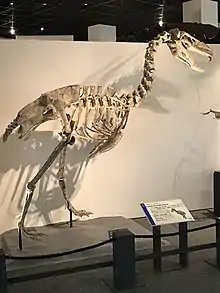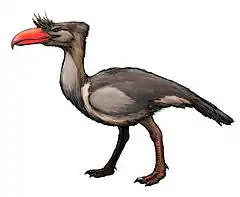Kelenken
Kelenken is a genus of giant flightless predatory birds of the extinct family Phorusrhacidae, or "terror birds". The type and only species is K. guillermoi, first formally described in 2007 after the find in 1999. It is the largest known member of the family.
| Kelenken | |
|---|---|
 | |
| Reconstructed skeleton | |
| Scientific classification | |
| Kingdom: | Animalia |
| Phylum: | Chordata |
| Class: | Aves |
| Order: | Cariamiformes |
| Family: | †Phorusrhacidae |
| Subfamily: | †Phorusrhacinae |
| Genus: | †Kelenken Bertelli et al. 2007 |
| Species: | †K. guillermoi |
| Binomial name | |
| †Kelenken guillermoi Bertelli et al. 2007 | |
Taxonomy

A fossil of the genus was discovered in March 1999 by student Guillermo Oscar Aguirre Zabala and a friend, about 100 metres (330 ft) from the train station of Comallo, a small village in the Río Negro Province, Argentina. They were fossil hunting and found other fossils before. After discovering the fossil, they contacted the paleontological museum in Bariloche. The fossil was handed to the museum and was in their collection for five years before being formally described. The find was studied by paleontologist Luis María Chiappe, together with Sara Bertelli and Claudia Tambussi. Later, a complete lower leg bone ascribed to Kelenken was found.[1]
The genus is named after Kélenken, a demon in the mythology of the Tehuelche people. The species epithet refers to Guillermo Aguirre Zabala, who discovered the holotype fossil.[2]
Kelenken is assigned to the subfamily Phorusrhacinae, a subfamily of terror birds up to 3.2 metres (10 ft) high, but somewhat slender and decidedly more nimble than the Brontornithinae, together with: Devincenzia, Late Oligocene to Early Miocene (Deseadan) Fray Bentos Formation of Uruguay, Kelenken, Colloncuran of Río Negro Province, Argentina; largest known phorusrhacid, Phorusrhacos, Early to Middle Miocene (Santacrucian) Santa Cruz Formation of Argentina, Titanis, Early Pliocene to Early Pleistocene (Blancan) of Florida and Texas.
Description

Kelenken lived in the Langhian stage of the Miocene, approximately 15 million years ago. Fossils were found in tuff beds of the Colloncuran Collón Curá Formation in the Cañadón Asfalto Basin of western Patagonia, Argentina.[3]
It was the largest species of phorusrhacid, and with a skull 71.6 centimetres (28.2 in) long, it possessed the largest head of any known bird.[4] The tarsometatarsus of one fossil specimen is 43.7 centimetres (17.2 in) long.[2] The discovery of the long leg bone led the researchers conclude Kelenken was a fast runner, more than other terror birds. The size of the skull and its jaw muscles led to the conclusion the terror bird had an enormous bite force.[1]
Paleobiology

Diet
It is not entirely clear how Kelenken captured and killed its prey. As a large flightless carnivore, Kelenken likely chased down and killed its prey with several bone-shattering blows from its massive beak, their diet that consists ranges from prehistoric rodents, to warm blooded mammals such as deer, young horses, cows, Llamas, sheep, and prehistoric sloths and armadillos. Another possibility is that it may have picked up its prey item, then proceeded to shake it vigorously in order to break its back. It is possible that Kelenken may also have been a scavenger, driving off other predators from their kills with its impressive size.
Paleoecology

The Collón Curá Formation represents a transition from a forested ecological biome to more open pampa-type of vegetation. The formation has provided a rich assemblage of mammals, among others the rodent Guiomys unica and the sparassodont Patagosmilus goini and reptiles, mainly snakes and tortoises.[5]
References
- Rehr, 2007, 5:40-11:40
- Bertelli et al., 2007
- Comallo at Fossilworks.org
- Jones, 2010, p.10
- Tonni & Carlini, 2008
Bibliography
- Bertelli, S.; L.M. Chiappe, and C. Tambussi. 2007. A new phorusrhacid (Aves: Cariamae) from the middle Miocene of Patagonia, Argentina. Journal of Vertebrate Paleontology 27. 409. Accessed 2018-09-30.
- Jones, Washington W. 2010. Nuevos aportes sobre la paleobiología de los Fororrácidos (Aves: Phorusrhacidae) basados en el análisis de estructuras biológicas (PhD thesis), 1–213. PEDECIBA. Accessed 2018-09-30.
- Rehr, Darryl. 2007. Prehistoric Predators - Terror Bird, 5:40–11:40. National Geographic. Accessed 2018-09-30.
- Tonni, Eduardo P., and Alfredo A. Carlini. 2008. Chapter 13, "Neogene Vertebrates from Argentine Patagonia: Their Relationship with the Most Significant Climatic Changes" in "J. Rabassa (ed.) The Late Cenozoic of Patagonia and Tierra del Fuego", 269–284. Elsevier Science.
Further reading
| Wikimedia Commons has media related to Kelenken. |
- Dalla Salda, Luis, and Juan Franzese. 1987. Las megaestructuras del Macizo y Cordillera Norpatagónica argentina y la génesis de las cuencas volcano-sedimentarias terciarias. Revista Geológica de Chile 31. 3–13. Accessed 2018-09-04.
- Degrange, F.J.; C.P. Tambussi; K. Moreno; L.M. Witmer, and S. Wroe. 2010. Mechanical Analysis of Feeding Behavior in the Extinct "Terror Bird" Andalgalornis steulleti (Gruiformes: Phorusrhacidae). PLoS ONE 5. e11856. Accessed 2018-09-30.
- Escosteguy, Leonardo, and Mario Franchi. 2010. Estratigrafía de la región de Chapelco, Provincia del Neuquén. Revista de la Asociación Geológica Argentina 66. 418–429. Accessed 2018-09-10.
- Kramarz, Alejandro; Alberto Garrido; Analía Forasiepi; Mariano Bond, and Claudia Tambussi. 2005. Estratigrafia y vertebrados (Aves y Mammalia) de la Formación Cerro Bandera, Mioceno Temprano de la Provincia del Neuquén, Argentina. Revista Geológica de Chile 32. 273–291. Accessed 2017-10-20.